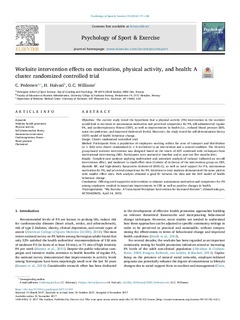| dc.contributor.author | Pedersen, Cathrine | |
| dc.contributor.author | Halvari, Halgeir | |
| dc.contributor.author | Williams, G.C. | |
| dc.date.accessioned | 2018-04-11T10:55:44Z | |
| dc.date.available | 2018-04-11T10:55:44Z | |
| dc.date.created | 2018-01-03T11:12:28Z | |
| dc.date.issued | 2017 | |
| dc.identifier.citation | Psychology of Sport and Exercise. 2017, 35, 171-180. | |
| dc.identifier.issn | 1469-0292 | |
| dc.identifier.uri | http://hdl.handle.net/11250/2493619 | |
| dc.description | This is an open access article under the CC BY-NC-ND license (http://creativecommons.org/licenses/BY-NC-ND/4.0/). | |
| dc.description.abstract | Objectives: The current study tested the hypothesis that a physical activity (PA) intervention in the worksite would lead to increases in autonomous motivation and perceived competence for PA, self-administered regular PA, and cardiorespiratory fitness (CRF), as well as improvements in health (i.e., reduced blood pressure (BP), waist circumference, and improved cholesterol levels). Moreover, the study tested the self-determination theory (SDT) model of health behaviour change. Design: Cluster randomized controlled trial. Method: Participants from a population of employees working within the area of transport and distribution (n = 202) were cluster randomized (n = 6 worksites) to an intervention and a control condition. The 16-week group-based worksite intervention was designed based on the tenets of SDT combined with techniques from motivational interviewing (MI). Participants were assessed at baseline and at post-test five months later. Results: Complete-case analyses applying multivariate and univariate analysis of variance indicated an overall intervention effect, and moderate to small effect sizes (Cohen's d) in favour of the intervention group on CRF, diastolic BP, and high-density lipoprotein cholesterol (HDL-C), as well as need support for PA, autonomous motivation for PA, and perceived competence for PA. Intention-to-treat analyses demonstrated the same pattern with smaller effect sizes. Path analysis obtained a good fit between the data and the SDT model of health behaviour change. Conclusions: Offering need supportive interventions to enhance autonomous motivation and competence for PA among employees resulted in important improvements in CRF as well as positive changes in health. Trial registration: “My Exercise. A Team-based Workplace Intervention for Increased Exercise”, clinicaltrials.gov, NCT02429635, April 14, 2015. | |
| dc.language.iso | eng | |
| dc.subject | worksite health promotion | |
| dc.subject | physical activity | |
| dc.subject | self-determination theory | |
| dc.subject | autonomous motivation | |
| dc.subject | cardiorespiratory fitness | |
| dc.subject | blood pressure | |
| dc.subject | cholesterol | |
| dc.title | Worksite intervention effects on motivation, physical activity, and health: A cluster randomized controlled trial | |
| dc.type | Peer reviewed | |
| dc.type | Journal article | |
| dc.description.version | publishedVersion | |
| dc.rights.holder | © 2017 The Authors. | |
| dc.source.pagenumber | 171-180 | |
| dc.source.volume | 35 | |
| dc.source.journal | Psychology of Sport and Exercise | |
| dc.source.issue | March | |
| dc.identifier.doi | 10.1016/j.psychsport.2017.11.004 | |
| dc.identifier.cristin | 1534550 | |
| dc.relation.project | Norges forskningsråd: 227874 | |
| dc.description.localcode | Seksjon for coaching og psykologi / Department of Coaching and Psychology | |
| cristin.unitcode | 150,32,0,0 | |
| cristin.unitname | Seksjon for coaching og psykologi | |
| cristin.ispublished | true | |
| cristin.fulltext | original | |
| cristin.qualitycode | 1 | |
